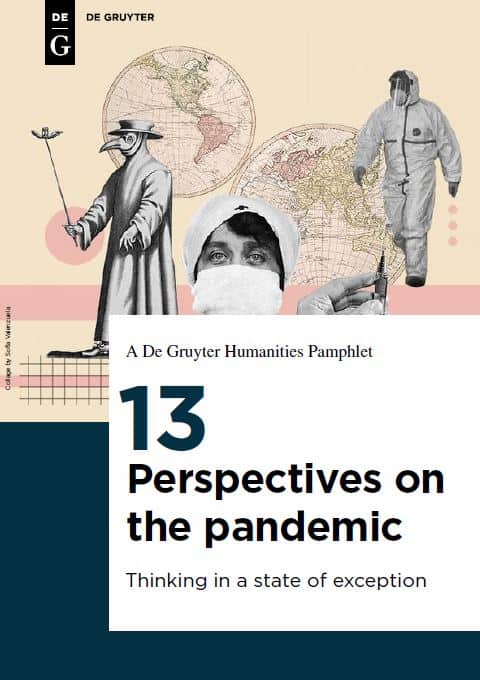From Justinianic Plague to Covid-19: A Timeless Story?
The news of SARS-CoV-2 spreading across the world and quarantine measures bring back to mind the terrible scourges of the past.
This essay was first published in the free digital pamphlet 13 Perspectives on
the Pandemic: Thinking in a state of exception.
One of the most devastating pandemics in human history was the first plague pandemic (sixth to eighth centuries), which was named after the Byzantine emperor of that time, Justinian. From the time of the Justinianic Plague to the current Covid-19 Pandemic, infectious diseases have been governed by fixed epidemiological and ecological models, which are ready to re-emerge anytime and anywhere on the planet beyond origins, nations, cultures, and religions.
The Basic Model of Epidemics
A simple model of an epidemic outbreak is the epidemiologic triad. From the time of the Justinianic Plague this triad consists of the external agent, the host, and the environment that brings them together. The onset of an epidemic, and the evolution to a pandemic, requires complex interactions between the three elements of the triad. The external agent includes microorganisms (bacteria, viruses, and parasites) characterized according to their infectivity (proportion of exposed individuals who become infected), pathogenicity (proportion of infected individuals who develop a clinically apparent disease), and virulence (proportion of clinically apparent cases that are severe or fatal).
The second element of the triad, the host, refers to the human population and the factors which can contribute to the exposure and susceptibility to the pathogens. The third element of the triad, the environment, comprises both environmental and biological factors. The environment is not just climatic or natural but also socioeconomic, with parameters such as overpopulation, sanitation, and level of the health services. From the medieval pandemics of plague until modern pandemics of H1N1 or SARS-CoV-2, the fundamentals of the epidemiologic triad have remained constant.
The “Compulsory Model” of Herd Immunity
The spectrum of a disease can range from mild to severe or fatal and the process can end in recovery, disability, or death of the patient. In some countries, the health services responded to the Covid-19 disease with the “aggressive” model of herd immunity. Generalizing the concept of the individual’s immunity, the immunity of a group is defined as herd immunity. If an adequate number of individuals are resistant to a pathogen (due to vaccination or previous infection), the susceptible persons will be protected by the resistant majority.
In the case of Justinian’s plague, 1,500 years ago, the Byzantine population was vulnerable to the pathogen. In a world without medical knowledge and vaccines, the herd immunity, as a result of the host-pathogen interaction, was the natural evolution of every disease, and the only protection against future outbreaks. The phenomenon of the “low level” of herd immunity can explain the mortality of populations in the Byzantine and western European cities in the time of the plague pandemics, because of the presence of immunologically “virgin” individuals and, also, the constant influx of new susceptible populations coming from outside. A typical example is the decimation of the native populations in the American continent after their first contact with the smallpox virus during the European colonization. Also indicative of this is the case of the smallpox epidemic in Iceland (1707). The epidemic decimated individuals born after the previous epidemic of 1672 who were not immune, since they had never come into contact with the virus.
Megacities Under Pandemics
“Throughout the history of pandemics, the great cities and trade centers of the world were struck by deadly infectious diseases.”
The images of the empty streets in the modern megacities was an unprecedented experience. Throughout the history of pandemics, the great cities and trade centers of the world were struck by deadly infectious diseases. Given that the plague epidemics were mainly of the “urban type”, it is conceivable that the cities would have been the primary target. In Justinian’s time, plagues appeared almost every 10–15 years in Constantinople and Rome. Also, during the time of the so-called Black Death, demography declined in a catastrophic way in Europe: Bremen lost 70 % of its population, Hamburg between 50 and 66 %, Venice 60 %, Genoa 58 %, Florence 52 %, Marseilles 50 %, London 40 %, and Paris 30 %.
It is evident that the medieval “megacities” were a dynamic population system. The massive movements of peoples never stopped and they resulted in urbanization and informal urban planning, which in turn led to the recycling of diseases or opening the door to new outbreaks.
Social Disturbances
The epidemics of the past, mainly the epidemics of medieval times, are construed as the predictable result of superstition and scientific ignorance of contemporary populations. The social behaviors that emerged during past pandemics seem strange and bizarre nowadays. But, beyond the cultural differences, modern humans appear to share the same collective fears and emotional reactions with the people of centuries past. If ignorance was the curse of the past, sciolism is the curse of modern humans. Despite the evolution of medicine, in the case of Covid-19 disease, a similar spectrum of individual and collective social behaviors has emerged. This spectrum spans from solidarity with the medical personnel and patients to conspiracy theories or stigmatization of nations.
Learn more in this related title from De Gruyter
[Title image via Wikimedia Commons, Public Domain]
